Economics Assignment - Elasticity, Monopoly Power, Australian Context
VerifiedAdded on 2023/01/17
|9
|2429
|22
Homework Assignment
AI Summary
This economics assignment delves into two core concepts: price elasticity of demand and monopoly power. The first part analyzes the price elasticity of demand for tobacco products, Starbucks coffee, and oil, drawing from recent research articles. It examines the factors influencing demand elasticity, such as the availability of substitutes and the nature of the product (necessity vs. luxury). The second part focuses on the Australian Post as an example of an organization with significant monopoly power. It explores the reasons behind the monopoly, its benefits, and the consumer losses associated with it. The assignment also discusses government intervention strategies, such as regulation, price capping, and taxation, to curb the potential negative effects of monopoly power. The analysis is supported by references to relevant literature and reports, providing a comprehensive understanding of these economic principles within the Australian context.
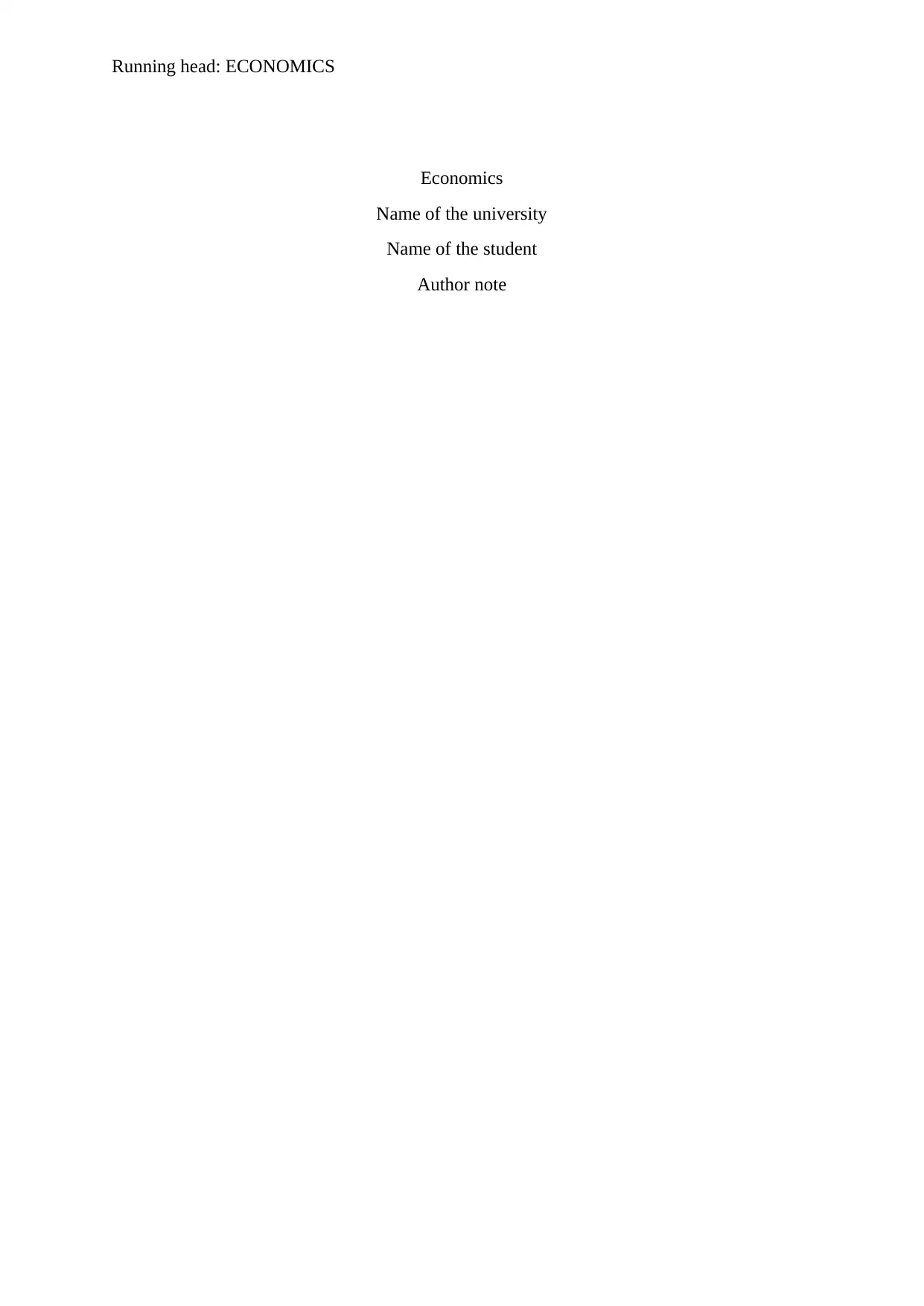
Running head: ECONOMICS
Economics
Name of the university
Name of the student
Author note
Economics
Name of the university
Name of the student
Author note
Paraphrase This Document
Need a fresh take? Get an instant paraphrase of this document with our AI Paraphraser
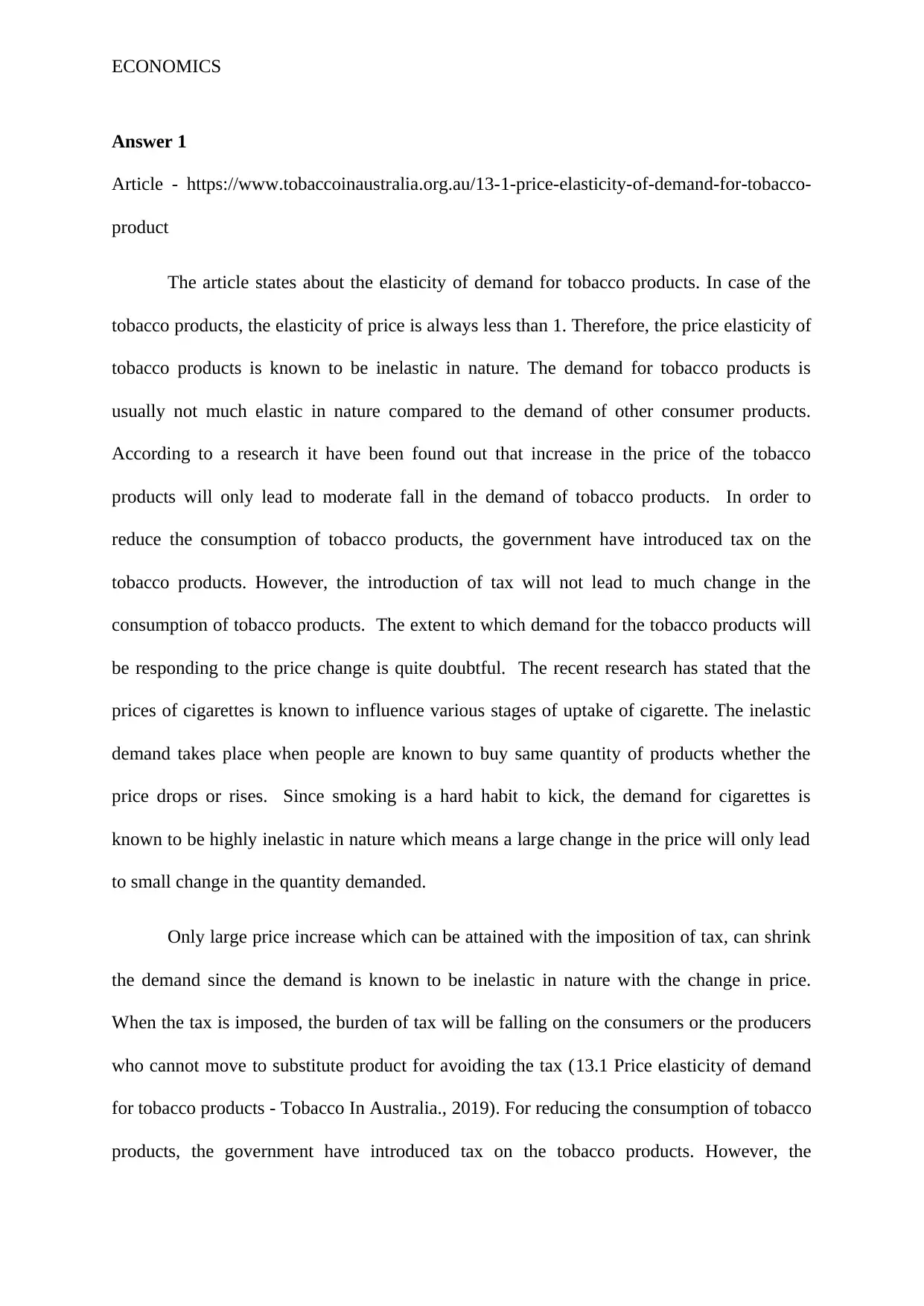
ECONOMICS
Answer 1
Article - https://www.tobaccoinaustralia.org.au/13-1-price-elasticity-of-demand-for-tobacco-
product
The article states about the elasticity of demand for tobacco products. In case of the
tobacco products, the elasticity of price is always less than 1. Therefore, the price elasticity of
tobacco products is known to be inelastic in nature. The demand for tobacco products is
usually not much elastic in nature compared to the demand of other consumer products.
According to a research it have been found out that increase in the price of the tobacco
products will only lead to moderate fall in the demand of tobacco products. In order to
reduce the consumption of tobacco products, the government have introduced tax on the
tobacco products. However, the introduction of tax will not lead to much change in the
consumption of tobacco products. The extent to which demand for the tobacco products will
be responding to the price change is quite doubtful. The recent research has stated that the
prices of cigarettes is known to influence various stages of uptake of cigarette. The inelastic
demand takes place when people are known to buy same quantity of products whether the
price drops or rises. Since smoking is a hard habit to kick, the demand for cigarettes is
known to be highly inelastic in nature which means a large change in the price will only lead
to small change in the quantity demanded.
Only large price increase which can be attained with the imposition of tax, can shrink
the demand since the demand is known to be inelastic in nature with the change in price.
When the tax is imposed, the burden of tax will be falling on the consumers or the producers
who cannot move to substitute product for avoiding the tax (13.1 Price elasticity of demand
for tobacco products - Tobacco In Australia., 2019). For reducing the consumption of tobacco
products, the government have introduced tax on the tobacco products. However, the
Answer 1
Article - https://www.tobaccoinaustralia.org.au/13-1-price-elasticity-of-demand-for-tobacco-
product
The article states about the elasticity of demand for tobacco products. In case of the
tobacco products, the elasticity of price is always less than 1. Therefore, the price elasticity of
tobacco products is known to be inelastic in nature. The demand for tobacco products is
usually not much elastic in nature compared to the demand of other consumer products.
According to a research it have been found out that increase in the price of the tobacco
products will only lead to moderate fall in the demand of tobacco products. In order to
reduce the consumption of tobacco products, the government have introduced tax on the
tobacco products. However, the introduction of tax will not lead to much change in the
consumption of tobacco products. The extent to which demand for the tobacco products will
be responding to the price change is quite doubtful. The recent research has stated that the
prices of cigarettes is known to influence various stages of uptake of cigarette. The inelastic
demand takes place when people are known to buy same quantity of products whether the
price drops or rises. Since smoking is a hard habit to kick, the demand for cigarettes is
known to be highly inelastic in nature which means a large change in the price will only lead
to small change in the quantity demanded.
Only large price increase which can be attained with the imposition of tax, can shrink
the demand since the demand is known to be inelastic in nature with the change in price.
When the tax is imposed, the burden of tax will be falling on the consumers or the producers
who cannot move to substitute product for avoiding the tax (13.1 Price elasticity of demand
for tobacco products - Tobacco In Australia., 2019). For reducing the consumption of tobacco
products, the government have introduced tax on the tobacco products. However, the
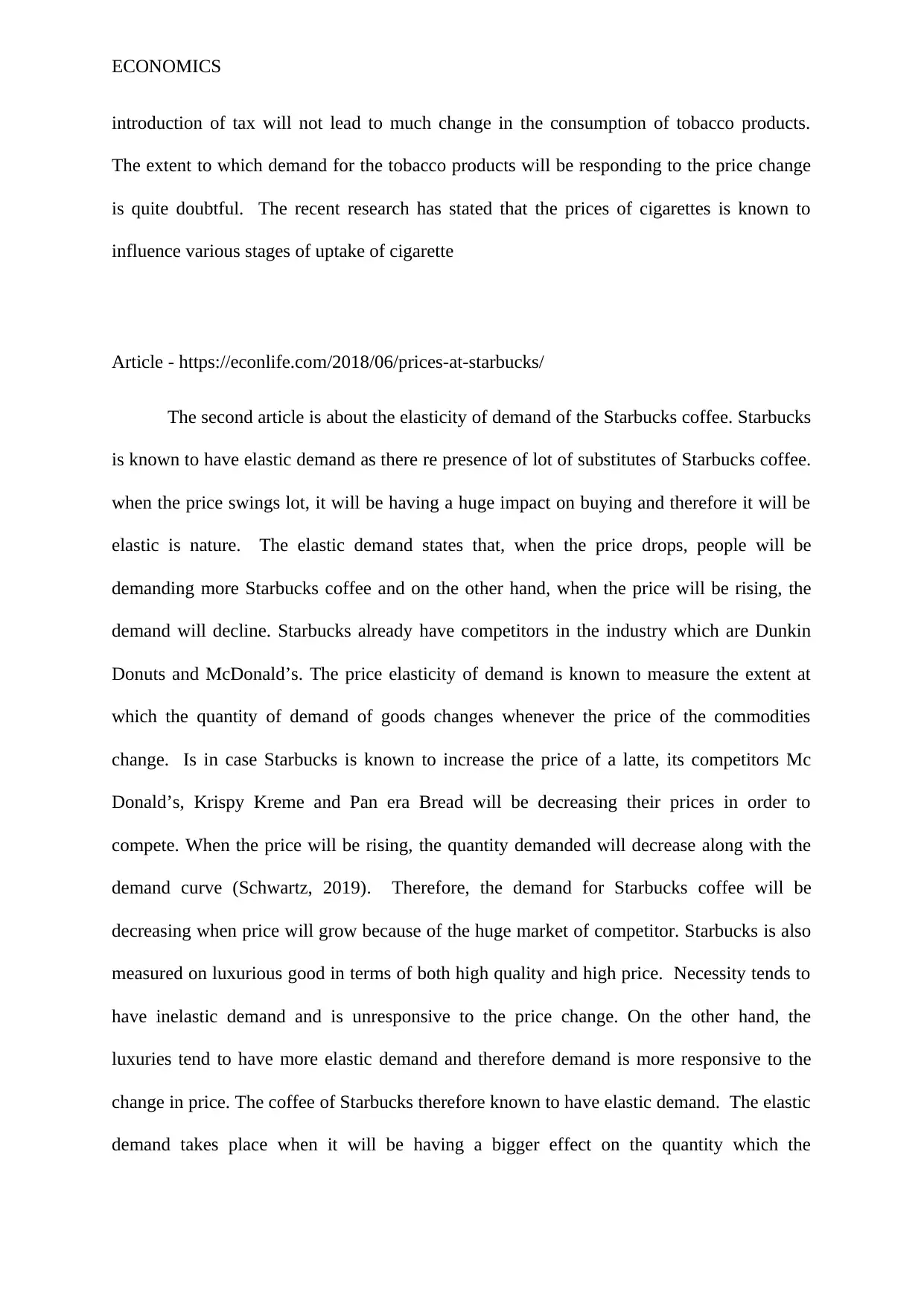
ECONOMICS
introduction of tax will not lead to much change in the consumption of tobacco products.
The extent to which demand for the tobacco products will be responding to the price change
is quite doubtful. The recent research has stated that the prices of cigarettes is known to
influence various stages of uptake of cigarette
Article - https://econlife.com/2018/06/prices-at-starbucks/
The second article is about the elasticity of demand of the Starbucks coffee. Starbucks
is known to have elastic demand as there re presence of lot of substitutes of Starbucks coffee.
when the price swings lot, it will be having a huge impact on buying and therefore it will be
elastic is nature. The elastic demand states that, when the price drops, people will be
demanding more Starbucks coffee and on the other hand, when the price will be rising, the
demand will decline. Starbucks already have competitors in the industry which are Dunkin
Donuts and McDonald’s. The price elasticity of demand is known to measure the extent at
which the quantity of demand of goods changes whenever the price of the commodities
change. Is in case Starbucks is known to increase the price of a latte, its competitors Mc
Donald’s, Krispy Kreme and Pan era Bread will be decreasing their prices in order to
compete. When the price will be rising, the quantity demanded will decrease along with the
demand curve (Schwartz, 2019). Therefore, the demand for Starbucks coffee will be
decreasing when price will grow because of the huge market of competitor. Starbucks is also
measured on luxurious good in terms of both high quality and high price. Necessity tends to
have inelastic demand and is unresponsive to the price change. On the other hand, the
luxuries tend to have more elastic demand and therefore demand is more responsive to the
change in price. The coffee of Starbucks therefore known to have elastic demand. The elastic
demand takes place when it will be having a bigger effect on the quantity which the
introduction of tax will not lead to much change in the consumption of tobacco products.
The extent to which demand for the tobacco products will be responding to the price change
is quite doubtful. The recent research has stated that the prices of cigarettes is known to
influence various stages of uptake of cigarette
Article - https://econlife.com/2018/06/prices-at-starbucks/
The second article is about the elasticity of demand of the Starbucks coffee. Starbucks
is known to have elastic demand as there re presence of lot of substitutes of Starbucks coffee.
when the price swings lot, it will be having a huge impact on buying and therefore it will be
elastic is nature. The elastic demand states that, when the price drops, people will be
demanding more Starbucks coffee and on the other hand, when the price will be rising, the
demand will decline. Starbucks already have competitors in the industry which are Dunkin
Donuts and McDonald’s. The price elasticity of demand is known to measure the extent at
which the quantity of demand of goods changes whenever the price of the commodities
change. Is in case Starbucks is known to increase the price of a latte, its competitors Mc
Donald’s, Krispy Kreme and Pan era Bread will be decreasing their prices in order to
compete. When the price will be rising, the quantity demanded will decrease along with the
demand curve (Schwartz, 2019). Therefore, the demand for Starbucks coffee will be
decreasing when price will grow because of the huge market of competitor. Starbucks is also
measured on luxurious good in terms of both high quality and high price. Necessity tends to
have inelastic demand and is unresponsive to the price change. On the other hand, the
luxuries tend to have more elastic demand and therefore demand is more responsive to the
change in price. The coffee of Starbucks therefore known to have elastic demand. The elastic
demand takes place when it will be having a bigger effect on the quantity which the
⊘ This is a preview!⊘
Do you want full access?
Subscribe today to unlock all pages.

Trusted by 1+ million students worldwide

ECONOMICS
consumers want to buy. Since the Starbucks coffee is considered to be a luxurious good, it is
going to have an inelastic demand.
Article- Does The Price Of Oil Even Matter?
The demand for oil has always been inelastic in nature. The reason is that, the oil has
only few direct substitutes. The article states that according to a study it has been found out
that in the short run, the average price the average price elasticity of demand in case of
gasoline is known to be -0.26. This suggest that with a 10 percent hike in the gasoline price, it
will be lowering the gasoline quantity demanded by only 2.6 percent. However, in case if
long run, the price elasticity of demand is found to be -0.58 percent which suggest that a 10
percent rise in the gasoline price will lead to 5.8 percent decline of gasoline demanded in the
long run. The effect of higher oil price although have been temporary and there has been an
upward trend in short period of time. The elasticity of demand for oil is known to be quite
small and for that reason, a slight decrease in demand. The demand for oil is also relatively
inelastic in nature with respect to income in the advanced OECD economies (What's the Price
Elasticity of Demand for Gasoline?. 2019). The income elasticity of demand mostly in case
of developing countries like that of China and India are quite higher and the elasticity of
demand is known to be close to one. Oil is known to be an essential scarce resource where
there is no cost effective alternatives to oil for producing oil. The price of oil is also known to
be volatile in nature since the supply and demand are inelastic in nature. The reason behind
this is that there is a limited supply of oil which also means that any disruption to the supply
of oil will be shifting the supply curve to the left that will also lead to sharp rise in price.
Answer 2
The Australian post is known to have a significant monopoly power in the industry.
The Australian post is known to hurt the small business by not allowing the private postal
consumers want to buy. Since the Starbucks coffee is considered to be a luxurious good, it is
going to have an inelastic demand.
Article- Does The Price Of Oil Even Matter?
The demand for oil has always been inelastic in nature. The reason is that, the oil has
only few direct substitutes. The article states that according to a study it has been found out
that in the short run, the average price the average price elasticity of demand in case of
gasoline is known to be -0.26. This suggest that with a 10 percent hike in the gasoline price, it
will be lowering the gasoline quantity demanded by only 2.6 percent. However, in case if
long run, the price elasticity of demand is found to be -0.58 percent which suggest that a 10
percent rise in the gasoline price will lead to 5.8 percent decline of gasoline demanded in the
long run. The effect of higher oil price although have been temporary and there has been an
upward trend in short period of time. The elasticity of demand for oil is known to be quite
small and for that reason, a slight decrease in demand. The demand for oil is also relatively
inelastic in nature with respect to income in the advanced OECD economies (What's the Price
Elasticity of Demand for Gasoline?. 2019). The income elasticity of demand mostly in case
of developing countries like that of China and India are quite higher and the elasticity of
demand is known to be close to one. Oil is known to be an essential scarce resource where
there is no cost effective alternatives to oil for producing oil. The price of oil is also known to
be volatile in nature since the supply and demand are inelastic in nature. The reason behind
this is that there is a limited supply of oil which also means that any disruption to the supply
of oil will be shifting the supply curve to the left that will also lead to sharp rise in price.
Answer 2
The Australian post is known to have a significant monopoly power in the industry.
The Australian post is known to hurt the small business by not allowing the private postal
Paraphrase This Document
Need a fresh take? Get an instant paraphrase of this document with our AI Paraphraser
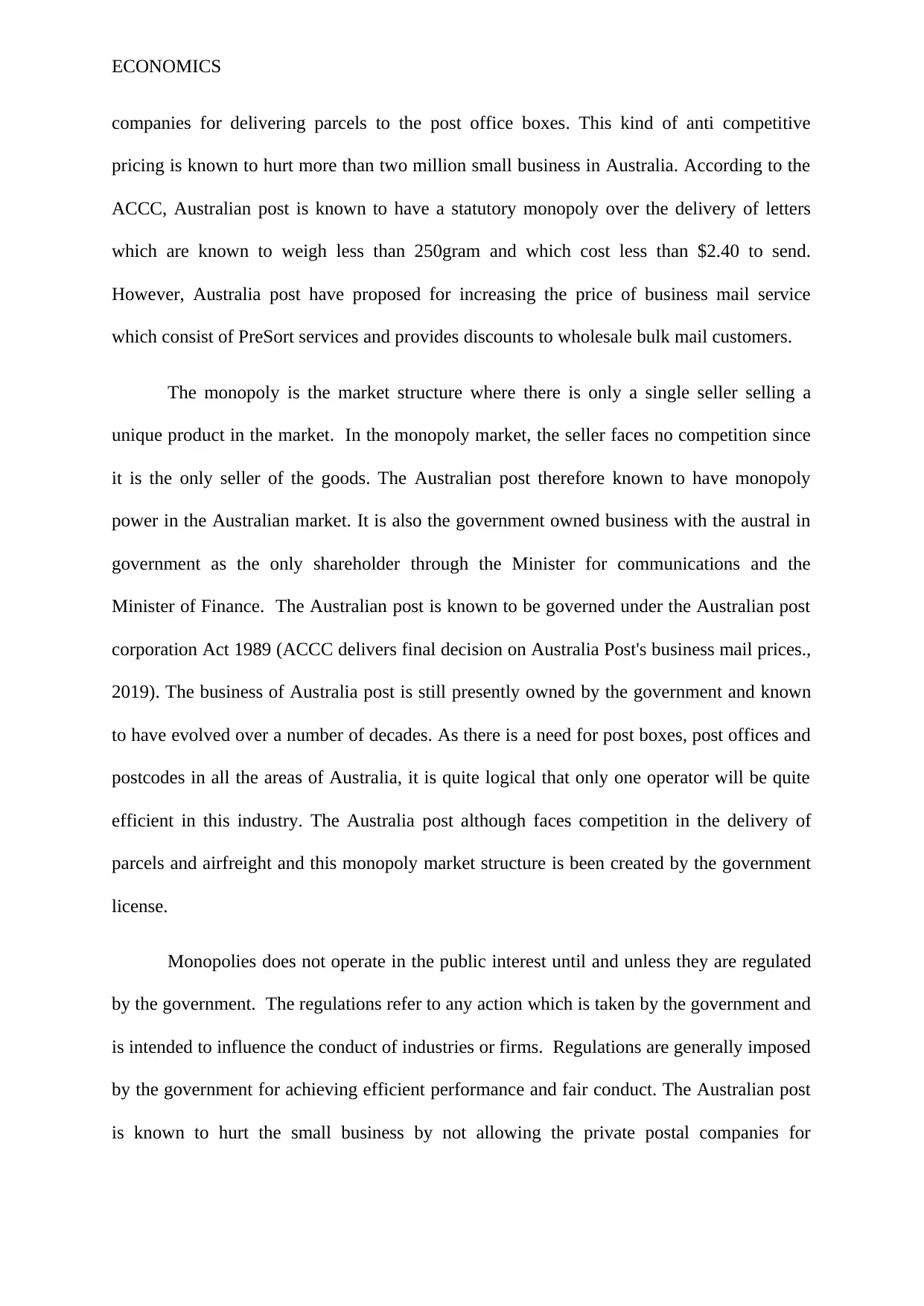
ECONOMICS
companies for delivering parcels to the post office boxes. This kind of anti competitive
pricing is known to hurt more than two million small business in Australia. According to the
ACCC, Australian post is known to have a statutory monopoly over the delivery of letters
which are known to weigh less than 250gram and which cost less than $2.40 to send.
However, Australia post have proposed for increasing the price of business mail service
which consist of PreSort services and provides discounts to wholesale bulk mail customers.
The monopoly is the market structure where there is only a single seller selling a
unique product in the market. In the monopoly market, the seller faces no competition since
it is the only seller of the goods. The Australian post therefore known to have monopoly
power in the Australian market. It is also the government owned business with the austral in
government as the only shareholder through the Minister for communications and the
Minister of Finance. The Australian post is known to be governed under the Australian post
corporation Act 1989 (ACCC delivers final decision on Australia Post's business mail prices.,
2019). The business of Australia post is still presently owned by the government and known
to have evolved over a number of decades. As there is a need for post boxes, post offices and
postcodes in all the areas of Australia, it is quite logical that only one operator will be quite
efficient in this industry. The Australia post although faces competition in the delivery of
parcels and airfreight and this monopoly market structure is been created by the government
license.
Monopolies does not operate in the public interest until and unless they are regulated
by the government. The regulations refer to any action which is taken by the government and
is intended to influence the conduct of industries or firms. Regulations are generally imposed
by the government for achieving efficient performance and fair conduct. The Australian post
is known to hurt the small business by not allowing the private postal companies for
companies for delivering parcels to the post office boxes. This kind of anti competitive
pricing is known to hurt more than two million small business in Australia. According to the
ACCC, Australian post is known to have a statutory monopoly over the delivery of letters
which are known to weigh less than 250gram and which cost less than $2.40 to send.
However, Australia post have proposed for increasing the price of business mail service
which consist of PreSort services and provides discounts to wholesale bulk mail customers.
The monopoly is the market structure where there is only a single seller selling a
unique product in the market. In the monopoly market, the seller faces no competition since
it is the only seller of the goods. The Australian post therefore known to have monopoly
power in the Australian market. It is also the government owned business with the austral in
government as the only shareholder through the Minister for communications and the
Minister of Finance. The Australian post is known to be governed under the Australian post
corporation Act 1989 (ACCC delivers final decision on Australia Post's business mail prices.,
2019). The business of Australia post is still presently owned by the government and known
to have evolved over a number of decades. As there is a need for post boxes, post offices and
postcodes in all the areas of Australia, it is quite logical that only one operator will be quite
efficient in this industry. The Australia post although faces competition in the delivery of
parcels and airfreight and this monopoly market structure is been created by the government
license.
Monopolies does not operate in the public interest until and unless they are regulated
by the government. The regulations refer to any action which is taken by the government and
is intended to influence the conduct of industries or firms. Regulations are generally imposed
by the government for achieving efficient performance and fair conduct. The Australian post
is known to hurt the small business by not allowing the private postal companies for

ECONOMICS
delivering parcels to the post office boxes. This kind of anti competitive pricing is known to
hurt more than two million small business in Australia.
The Australia post have also claimed that removing the monopoly over letter would
lead to huge adverse impacts on its profitability and would have forced it to retrench huge
number staffs for restoring its profitability. The monopoly power can be maintained by
barriers to entry which includes economies of large-scale production, limit pricing and
predatory pricing. A monopoly market is known to generate less surplus and is also less
efficient than a competitive market and therefore lead to deadweight loss. The Australian post
therefore known to have monopoly power in the Australian market. It is also the government
owned business with the Australian government as the only shareholder through the Minister
for communications and the Minister of Finance. The Australian post is known to be
governed under the Australian post corporation Act 1989. The business of Australia post is
still presently owned by the government and known to have evolved over a number of
decades.
The Australian post is known to have a significant monopoly power in the industry.
The Australian post is known to hurt the small business by not allowing the private postal
companies for delivering parcels to the post office boxes. This kind of anti competitive
pricing is known to hurt more than two million small business in Australia. According to the
ACCC, Australian post is known to have a statutory monopoly over the delivery of letters
which are known to weigh less than 250gram and which cost less than $2.40 to send. As there
is a need for post boxes, post offices and postcodes in all the areas of Australia, it is quite
logical that only one operator will be quite efficient in this industry. The consumers mostly,
loses from monopoly power since they do not have the power to bargain and therefore, the
consumers are at a huge loss. As the sole supplier, a monopoly can also refuse to serve its
customers and when the monopolies are known to be privately owned, prices are known to
delivering parcels to the post office boxes. This kind of anti competitive pricing is known to
hurt more than two million small business in Australia.
The Australia post have also claimed that removing the monopoly over letter would
lead to huge adverse impacts on its profitability and would have forced it to retrench huge
number staffs for restoring its profitability. The monopoly power can be maintained by
barriers to entry which includes economies of large-scale production, limit pricing and
predatory pricing. A monopoly market is known to generate less surplus and is also less
efficient than a competitive market and therefore lead to deadweight loss. The Australian post
therefore known to have monopoly power in the Australian market. It is also the government
owned business with the Australian government as the only shareholder through the Minister
for communications and the Minister of Finance. The Australian post is known to be
governed under the Australian post corporation Act 1989. The business of Australia post is
still presently owned by the government and known to have evolved over a number of
decades.
The Australian post is known to have a significant monopoly power in the industry.
The Australian post is known to hurt the small business by not allowing the private postal
companies for delivering parcels to the post office boxes. This kind of anti competitive
pricing is known to hurt more than two million small business in Australia. According to the
ACCC, Australian post is known to have a statutory monopoly over the delivery of letters
which are known to weigh less than 250gram and which cost less than $2.40 to send. As there
is a need for post boxes, post offices and postcodes in all the areas of Australia, it is quite
logical that only one operator will be quite efficient in this industry. The consumers mostly,
loses from monopoly power since they do not have the power to bargain and therefore, the
consumers are at a huge loss. As the sole supplier, a monopoly can also refuse to serve its
customers and when the monopolies are known to be privately owned, prices are known to
⊘ This is a preview!⊘
Do you want full access?
Subscribe today to unlock all pages.

Trusted by 1+ million students worldwide
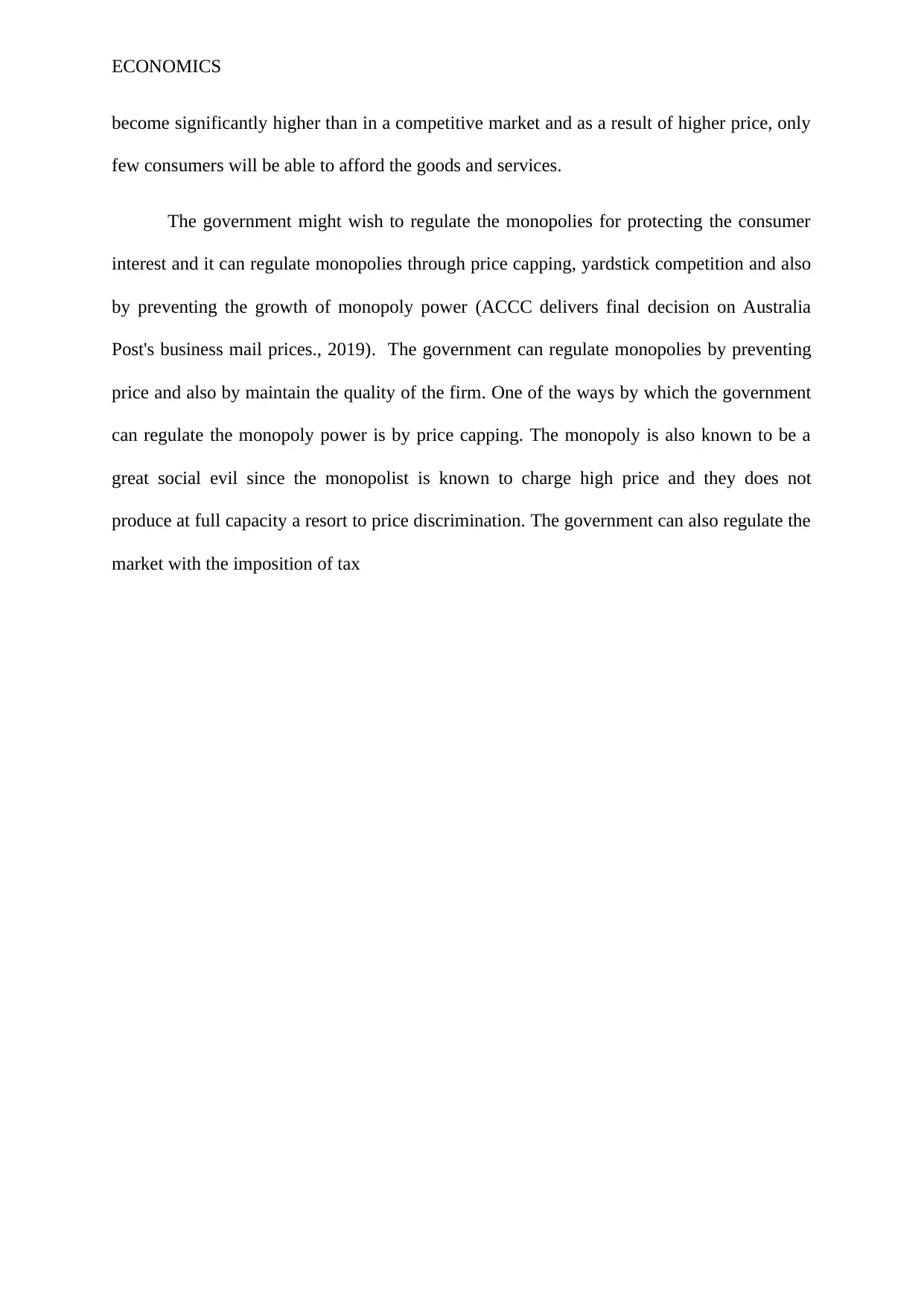
ECONOMICS
become significantly higher than in a competitive market and as a result of higher price, only
few consumers will be able to afford the goods and services.
The government might wish to regulate the monopolies for protecting the consumer
interest and it can regulate monopolies through price capping, yardstick competition and also
by preventing the growth of monopoly power (ACCC delivers final decision on Australia
Post's business mail prices., 2019). The government can regulate monopolies by preventing
price and also by maintain the quality of the firm. One of the ways by which the government
can regulate the monopoly power is by price capping. The monopoly is also known to be a
great social evil since the monopolist is known to charge high price and they does not
produce at full capacity a resort to price discrimination. The government can also regulate the
market with the imposition of tax
become significantly higher than in a competitive market and as a result of higher price, only
few consumers will be able to afford the goods and services.
The government might wish to regulate the monopolies for protecting the consumer
interest and it can regulate monopolies through price capping, yardstick competition and also
by preventing the growth of monopoly power (ACCC delivers final decision on Australia
Post's business mail prices., 2019). The government can regulate monopolies by preventing
price and also by maintain the quality of the firm. One of the ways by which the government
can regulate the monopoly power is by price capping. The monopoly is also known to be a
great social evil since the monopolist is known to charge high price and they does not
produce at full capacity a resort to price discrimination. The government can also regulate the
market with the imposition of tax
Paraphrase This Document
Need a fresh take? Get an instant paraphrase of this document with our AI Paraphraser
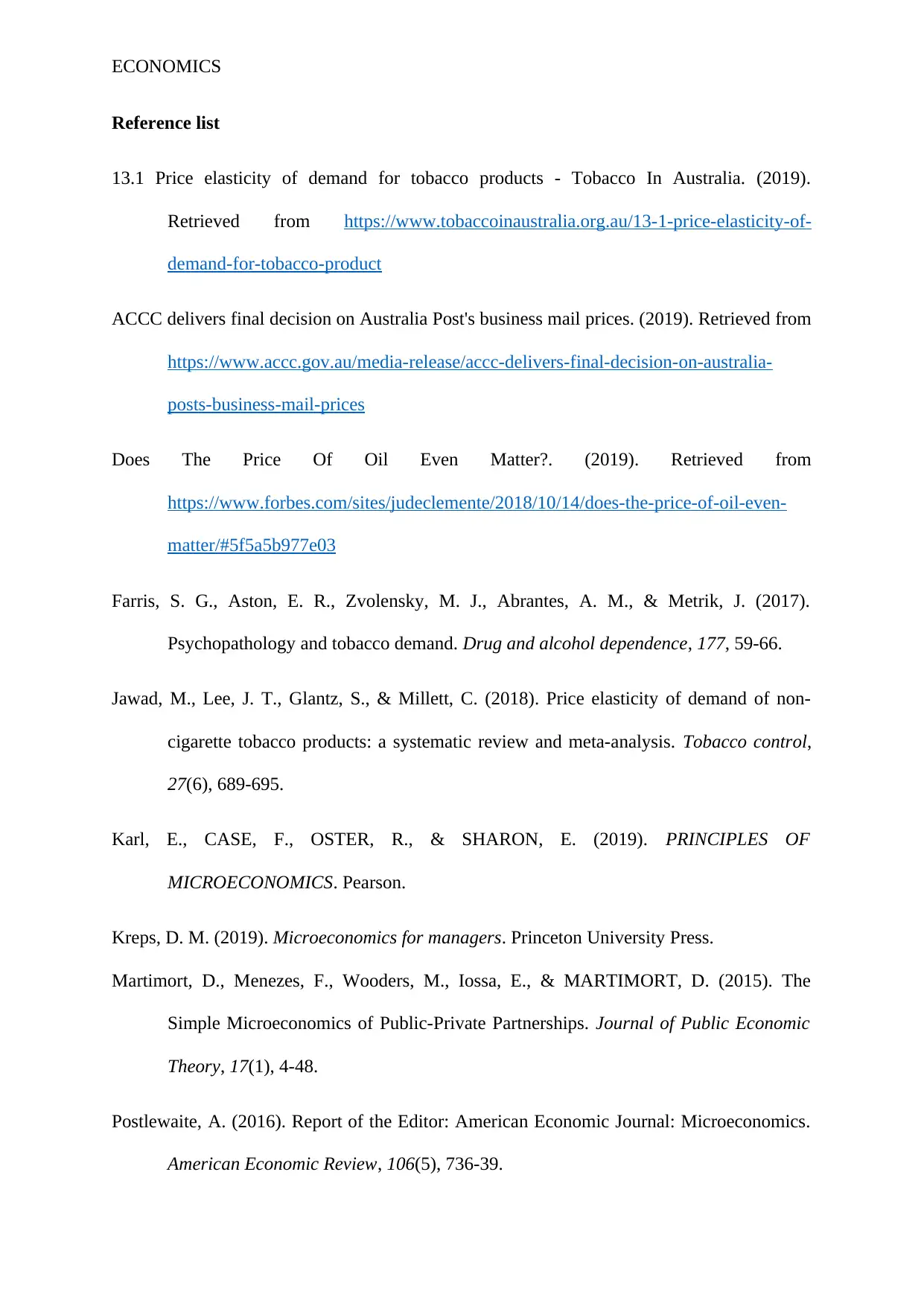
ECONOMICS
Reference list
13.1 Price elasticity of demand for tobacco products - Tobacco In Australia. (2019).
Retrieved from https://www.tobaccoinaustralia.org.au/13-1-price-elasticity-of-
demand-for-tobacco-product
ACCC delivers final decision on Australia Post's business mail prices. (2019). Retrieved from
https://www.accc.gov.au/media-release/accc-delivers-final-decision-on-australia-
posts-business-mail-prices
Does The Price Of Oil Even Matter?. (2019). Retrieved from
https://www.forbes.com/sites/judeclemente/2018/10/14/does-the-price-of-oil-even-
matter/#5f5a5b977e03
Farris, S. G., Aston, E. R., Zvolensky, M. J., Abrantes, A. M., & Metrik, J. (2017).
Psychopathology and tobacco demand. Drug and alcohol dependence, 177, 59-66.
Jawad, M., Lee, J. T., Glantz, S., & Millett, C. (2018). Price elasticity of demand of non-
cigarette tobacco products: a systematic review and meta-analysis. Tobacco control,
27(6), 689-695.
Karl, E., CASE, F., OSTER, R., & SHARON, E. (2019). PRINCIPLES OF
MICROECONOMICS. Pearson.
Kreps, D. M. (2019). Microeconomics for managers. Princeton University Press.
Martimort, D., Menezes, F., Wooders, M., Iossa, E., & MARTIMORT, D. (2015). The
Simple Microeconomics of Public-Private Partnerships. Journal of Public Economic
Theory, 17(1), 4-48.
Postlewaite, A. (2016). Report of the Editor: American Economic Journal: Microeconomics.
American Economic Review, 106(5), 736-39.
Reference list
13.1 Price elasticity of demand for tobacco products - Tobacco In Australia. (2019).
Retrieved from https://www.tobaccoinaustralia.org.au/13-1-price-elasticity-of-
demand-for-tobacco-product
ACCC delivers final decision on Australia Post's business mail prices. (2019). Retrieved from
https://www.accc.gov.au/media-release/accc-delivers-final-decision-on-australia-
posts-business-mail-prices
Does The Price Of Oil Even Matter?. (2019). Retrieved from
https://www.forbes.com/sites/judeclemente/2018/10/14/does-the-price-of-oil-even-
matter/#5f5a5b977e03
Farris, S. G., Aston, E. R., Zvolensky, M. J., Abrantes, A. M., & Metrik, J. (2017).
Psychopathology and tobacco demand. Drug and alcohol dependence, 177, 59-66.
Jawad, M., Lee, J. T., Glantz, S., & Millett, C. (2018). Price elasticity of demand of non-
cigarette tobacco products: a systematic review and meta-analysis. Tobacco control,
27(6), 689-695.
Karl, E., CASE, F., OSTER, R., & SHARON, E. (2019). PRINCIPLES OF
MICROECONOMICS. Pearson.
Kreps, D. M. (2019). Microeconomics for managers. Princeton University Press.
Martimort, D., Menezes, F., Wooders, M., Iossa, E., & MARTIMORT, D. (2015). The
Simple Microeconomics of Public-Private Partnerships. Journal of Public Economic
Theory, 17(1), 4-48.
Postlewaite, A. (2016). Report of the Editor: American Economic Journal: Microeconomics.
American Economic Review, 106(5), 736-39.
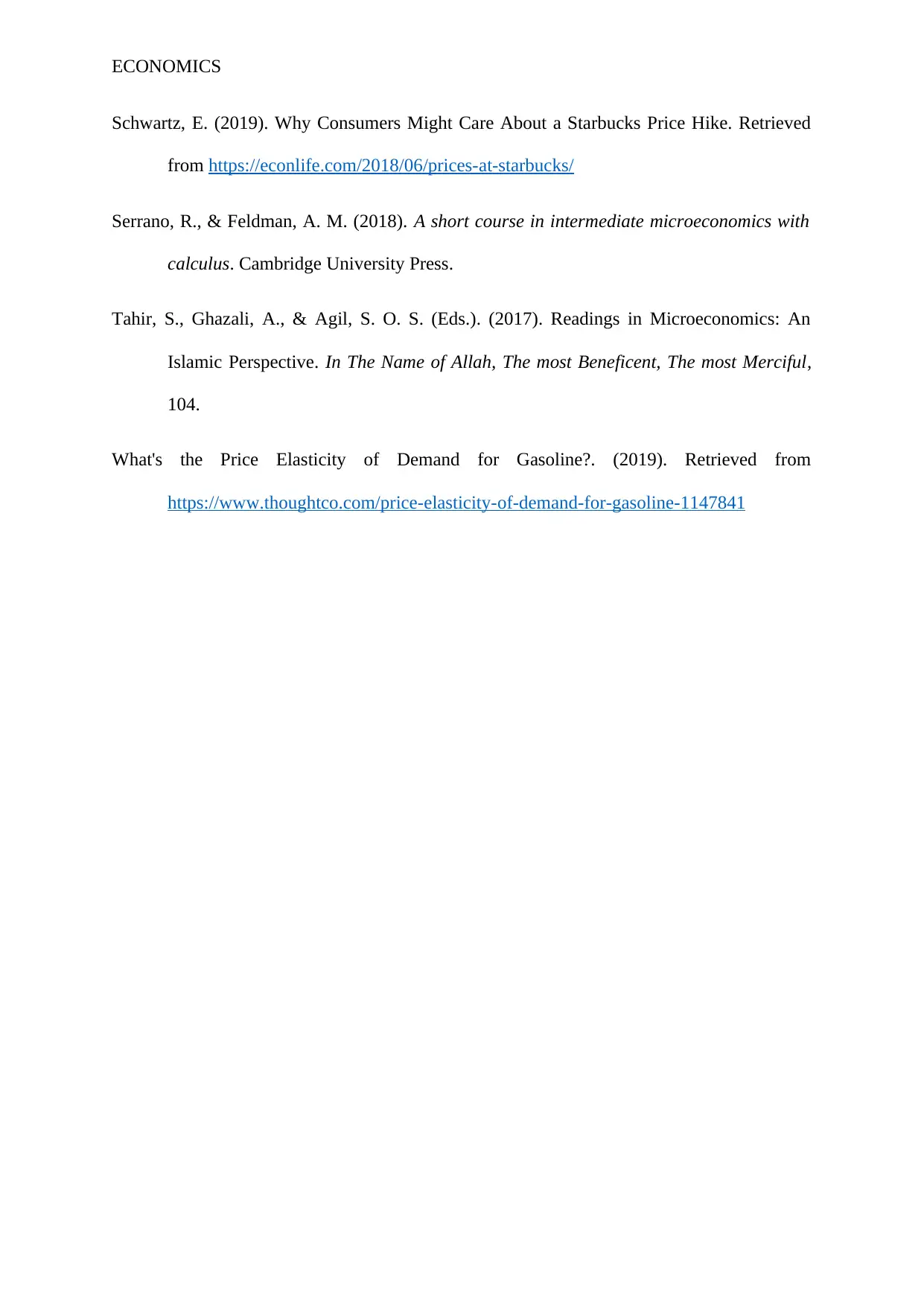
ECONOMICS
Schwartz, E. (2019). Why Consumers Might Care About a Starbucks Price Hike. Retrieved
from https://econlife.com/2018/06/prices-at-starbucks/
Serrano, R., & Feldman, A. M. (2018). A short course in intermediate microeconomics with
calculus. Cambridge University Press.
Tahir, S., Ghazali, A., & Agil, S. O. S. (Eds.). (2017). Readings in Microeconomics: An
Islamic Perspective. In The Name of Allah, The most Beneficent, The most Merciful,
104.
What's the Price Elasticity of Demand for Gasoline?. (2019). Retrieved from
https://www.thoughtco.com/price-elasticity-of-demand-for-gasoline-1147841
Schwartz, E. (2019). Why Consumers Might Care About a Starbucks Price Hike. Retrieved
from https://econlife.com/2018/06/prices-at-starbucks/
Serrano, R., & Feldman, A. M. (2018). A short course in intermediate microeconomics with
calculus. Cambridge University Press.
Tahir, S., Ghazali, A., & Agil, S. O. S. (Eds.). (2017). Readings in Microeconomics: An
Islamic Perspective. In The Name of Allah, The most Beneficent, The most Merciful,
104.
What's the Price Elasticity of Demand for Gasoline?. (2019). Retrieved from
https://www.thoughtco.com/price-elasticity-of-demand-for-gasoline-1147841
⊘ This is a preview!⊘
Do you want full access?
Subscribe today to unlock all pages.

Trusted by 1+ million students worldwide
1 out of 9
Related Documents
Your All-in-One AI-Powered Toolkit for Academic Success.
+13062052269
info@desklib.com
Available 24*7 on WhatsApp / Email
![[object Object]](/_next/static/media/star-bottom.7253800d.svg)
Unlock your academic potential
Copyright © 2020–2025 A2Z Services. All Rights Reserved. Developed and managed by ZUCOL.




